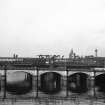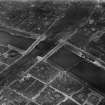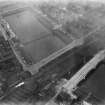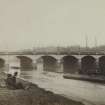Following the launch of trove.scot in February 2025 we are now planning the retiral of some of our webservices. Canmore will be switched off on 24th June 2025. Information about the closure can be found on the HES website: Retiral of HES web services | Historic Environment Scotland
Glasgow, Upper Harbour, Glasgow Bridge
Road Bridge (19th Century)
Site Name Glasgow, Upper Harbour, Glasgow Bridge
Classification Road Bridge (19th Century)
Alternative Name(s) River Clyde; New Bridge; Jamaica Bridge; Broomielaw Bridge; Jamaica Street; Clyde Street; Custom House Quay; Bridge Street; Carlton Place
Canmore ID 161900
Site Number NS56SE 444.01
NGR NS 58763 64791
Datum OSGB36 - NGR
Permalink http://canmore.org.uk/site/161900
- Council Glasgow, City Of
- Parish Glasgow (City Of Glasgow)
- Former Region Strathclyde
- Former District City Of Glasgow
- Former County Lanarkshire
NS56SE 444 58763 64785
Location formerly cited as NS 58763 64785.
Glasgow Bridge [NAT]
OS 1:1250 map, 1967.
For Telford's bridge and other predecessor bridges, see NS56SE 2159.
Glasgow Bridge, built 1894-9, Blyth and Westland, enginers (£129,500), replacing an earlier bridge designed by Thomas Telford, engineer. A seven-arched masonry bridge, with granite facing, part of which came from the old bridge. Each arch has three transverse arches, and the width of te bridge is 80ft [24.4m].
J R Hume 1974.
Glasgow (or Jamaica Street) Bridge. Built in 1895-9. Engineer Blyth and Westland of Edinburgh; contractor Blyth and Westland of Edinburgh; steel cylinders for foundations by Sir Wm Arrol and Co. It replaced a handsome seven-arched bridge in classical style by Thomas Telford, which was too narrow, its foundations too shallow, and the size of its arches inconvenient for shipping. Blyth and Westland therefore made a design of four larger arches with a roadway 100ft (30m) wide, but had to alter it to a virtual replica of the former bridge, with 80ft (24m) roadway, after 'an outcry in Glasgow against not retaining the beautiful lines of Telford's bridge' and objections from the Corporation to the estimated cost. The engineers, and doubtless the shipowners, thought it a very retrograde change.
The piers stand on concrete-filled steel cylinders sunk by the compressed-air method to a minimum depth of 23m (75ft) below the arch springings. Semicircular arches above low-water level link the heads of fourt cylinders to make up each pier. The piers, arches and facades of the bridge are of grey granite, much of it taken from the olds bridge and redressed, and the old balustrades and copestones were also redressed and polished. Only the pedestals over the piers depart from Telfords architectural treatment. Like the pilasters they replace, they are semi-octagonal in plan, but more bulky and with S-curved vertical profiles.
E Williamson, A Riches and M Higgs 1990.
This bridge carries a public road across the River Clyde, between Jamaica Street, Clyde Street, Custom House Quay and the Broomielaw (to the N), and Bridge Street and Carlton Place (to the S). It is situated at the downstream (W) end of the Upper Harbour, and its the easternmost of the Central Glasgow group of bridges, the others being the approach viaducts (NS56SE 140.00) to Central Station, and the King George V Bridge (NS 56SE 520). The river here forms the boundary between the civil parishes of Glasgow (to the N) and Govan (to the S).
The location cited defines the centre of the main span. The available map evidence indicates that the bridge extends from NS 58782 64868 to NS 58745 64710.
Information from RCAHMS (RJCM), 19 December 2005.
Architect:
Robert Mylne, 1768. John Adams of Glasgow, builder. 1768-1772
EXTERNAL REFERENCE:
Mitchell Library:
'William Graham' Volume I p.1 - photograph of print, 1802.
'Glasgow in Former Times' Volume I p.109 - lithograph, 1802.
Volume II p.126 - engraving
The Broomielaw Bridges:
The first bridge was erected in 1768-1772. The second, designed by Telford, was erected in 1836. Later an iron railway bridge was built to the West of Telford's Bridge.
Glasgow, Glasgow Bridge.
ARCHITECT: Robert Mylne 1774 (1st bridge)
Thomas Telford, 1833-36 (2nd bridge)
Blyth and Westland 1895-9 (3rd bridge) Jamaica bridge
Project (2007)
This project was undertaken to input site information listed in 'Civil engineering heritage: Scotland - Lowlands and Borders' by R Paxton and J Shipway, 2007.
Publication Account (2007)
Jamaica Street or Glasgow Bridge - Telford’s classical style seven-arch masonry bridge erected at the Broomielaw by Gibb & Son, resident engineer Atherton (the team from Dean Bridge, Edinburgh), from 1833–35 was the widest in Britain at the time. It replaced a masonry seven-arch, 42 ft wide bridge designed by Mylne and built from 1768–72 by John Adam (NS56SE 444.00).
In 1892 Blyth & Westland proposed a granite arch bridge with four spans from 88 ft–92 1/2 ft and 100 ft wide between parapets, estimated to cost £240 000. Glasgow Corporation declined this proposal because, apart from costing more than rebuilding the original, Telford’s bridge was held in high regard by Glasgow people. In 1894 work began and Telford’s elevation with its gently curving extrados rising less than 3 ft from the banks to the centre and spans from 52 ft to 58 ft 10 in. was retained. Much of the original Aberdeen granite was reused and the bridge, completed in 1899 cost just over £100 000.
The present bridge is 20 ft wider than its predecessor at 80 ft and has much deeper foundations consisting, instead of timber piles, of 15 ft diameter steel cylinders sunk by pneumatic pressure. Excavation for these piers was done manually in a 9 ft high air compression chamber, 43 lb sq in. of pressure being required at the greatest depth, a condition under which it was almost impossible to get the men to work. The cylinders were then filled with concrete. Some piers are founded more than 100 ft below springing level. A temporary eight-span bridge 60 ft wide consisting of steel beams on timber piles was erected to accommodate traffic during construction. The engineers were Blyth & Westland and the contractor, Morrison & Mason, Glasgow, with steelwork by Sir William Arrol & Co. Sir Alexander Gibb dubbed Telford’s creation ‘perhaps the most beautiful of all his bridges . . . a fitting crown to his creative life’. Despite developments since 1835 it is still possible to appreciate something of the bridge’s style and elegance.
R Paxton and J Shipway 2007
Reproduced from 'Civil Engineering heritage: Scotland - Lowlands and Borders' with kind permission of Thomas Telford Publishers.




































































































